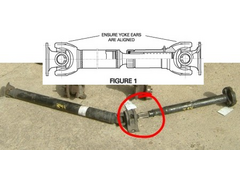I question? in a BEC car can I use one of those rigid props I have, or I have to get a splined one?
thks
Amadeu


Rescued attachment Sierra-PropShaft-2.jpg

I've seen those propshafts in many pics (like the one I show) with the first section movable with a splined piece. I've colected three, one
of a Escort, other from Sierra plus another from a Scorpio, but no one of them has that splined section. All are composed of two rigid sections.
I question? in a BEC car can I use one of those rigid props I have, or I have to get a splined one?
thks
Amadeu


Rescued attachment Sierra-PropShaft-2.jpg
If its a Sierra diff unit fixed to the chassis there isn't much need for a sliding joint.
Its there for the axial arc movement a live axle produces.
However I would still use the rubber dough nut to cater for any small movements and it will help smooth out the inherent backlash you get from bike
engines.
you need the sliding bit for engine movement aswell otherwise the prop would be being made take tension and compressive forces, or does the rubber pat allow for that
Transits have the sliding section, but if it's a fixed diff then the rubber cush drive or a TRT prop will do.
and... how did two piece rigid propshafts worked on Escorts mk2 with live axles? there were no sliding section to compensate axle movement... how did it worked?
Presumably they must have had the centre joint in the propshaft positioned so that as the axle moved up and down the rear section of propshaft
didn't need to change length, eg moving on the same arc as the trailing arms.
Either that or lots of chunks or rubber in there somewhere!
An excellent source of sliding joint propshafts for locosters is old Volvos. 740's and the like. They all seem to have sliding splined two
peice props, and the UJ's are the rebuildable, circlip type. This means you can swap different yokes onto the uj's and make up a custom
prop without spending lots of money!
I bought the yokes for mine from a company called Bailey Morris, and made up a 2 piece sliding joint prop for my bike engined locost. Can't
remeber how much the parts cost, maybe £50 or so.
Mark
quote:
Originally posted by xico_ze54
and... how did two piece rigid propshafts worked on Escorts mk2 with live axles? there were no sliding section to compensate axle movement... how did it worked?
Do a search for props, I have written so much in the past!
The diagram in the original post of the short slip shaft is a typical shaft you would buy from a prop firm. All parts are available new for ALL Ford
diffs and gearboxes (with flange or splines, not guibo).
You need a splined section in the shaft unless it is a limited life shaft for a race car with fixed diff and solid mount engine. These typically use
kevlar flex discs. You could probably get away with the guibo on a kit car but I would not on my car.
The best bet is to take the parts you have to a prop firm and get them to build you a shaft. You can use the bits you have but will need a cebtre
bearing which on a short shaft is not worth the hassle.
Many older props are interchangable. There is 1140, 1300, 1310, 1330, 1350, 1410 etc series. The Volvos mentioned use 1140 as do many Fords, Morris
Minors, etc. Landrovers use 1300 or 1310. So it is possible to mix and match. But all parts are available new.
John
(worked with props for 6 years and built 100`s of kit car props)
quote:
Originally posted by xico_ze54
and... how did two piece rigid propshafts worked on Escorts mk2 with live axles? there were no sliding section to compensate axle movement... how did it worked?